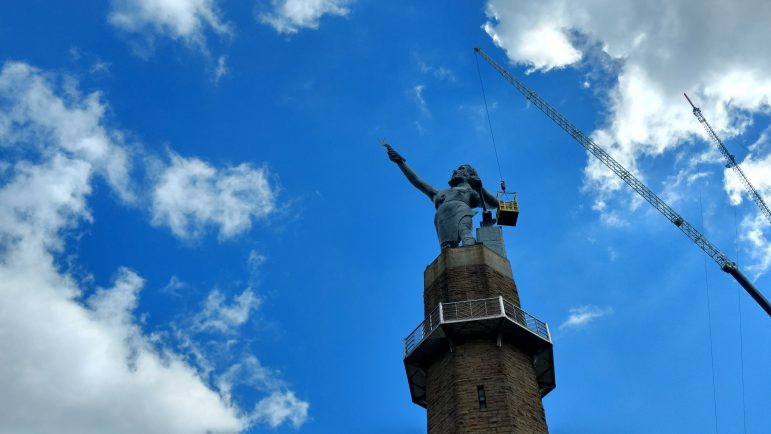The world’s largest cast iron statue is getting a fresh coat of paint, bare bottom and all. The 56-foot-tall Vulcan atop Red Mountain is an iconic part of Birmingham’s iron beginnings. But painting a 100,000-pound metal statue is no small undertaking.
Vulcan has a long history of disrepair.
Some of the cast iron statue’s greatest hits include having his right arm put on backwards when he was put together at the Alabama State Fair Grounds in 1906. Then there was his deterioration in 1999 that left his arm hanging by one bolt. And at the same time, the hollow statue was filled to the waist with concrete, which expanded and contracted with the weather and began to seep out of his body.
“He’s a survivor,” says Joe Saling, director of visitor experience at Vulcan Park and Museum.
This week Vulcan is getting a fresh coat of paint. The God of Smithing has seen worse days, but he has chips across his body and he’s dulled in the seven years since his last painting. That’s why the park hired Vulcan Painters to apply a fresh coat —who, despite the name, do more than paint Vulcan.
The process starts with a 180 foot crane lifting workers up to the statue. He’s then power washed to get rid of the dirt and grime.
Saling says it’s more of a gentle hosing than a high pressure blast. “So it’s not with any acid or anything strong. It’s a very light bath. So he’s getting a Jergens smoothing lotion bath today.”
The painters then smooth out the statue’s surface and clean off the remaining rust with power tools while applying primer. Saling says not just any primer will do.
“It’s not the stuff you would go and get at Home Depot and put on there,” he says. “It’s state of the art and high quality so it will last a long time.”
All this before they start applying about 20 gallons of gray paint. But the statue has to endure severe exposure to the elements, so in about 10 years, crews will go through the process again.
“Well I think it’s worth it,” says Saling. “I mean I think to keep the guy looking good, the big man looking good, a 10-year span is not bad at all, I don’t think.”
He adds Vulcan means a lot to the city. “It’s no different than the arch in Saint Louis. I mean, Vulcan represents Birmingham.”
Birmingham resident Warren Denson agrees.
“It’s the ironman of the city,” he says.
At Railroad Park, about a mile and half north and 500 feet below Vulcan’s feet, Denson can spot Vulcan between Children’s of Alabama and Regions Field. He has his own personal memories of Vulcan. When he was a kid, he’d ride his bike up the steep roads to the statue’s base.
“So that used to be our goal to ride all the way from downtown all the way up with our bicycle,” he says. “Once we make it up there we felt like we done accomplish something. So that be part of our summer there.”
Once the painting is finished, Denson and other visitors can make the trek to see a freshened up Vulcan shine above the city.
Note: Vulcan Park and Museum is a sponsor of WBHM programming. WBHM’s business and news departments operate separately.

